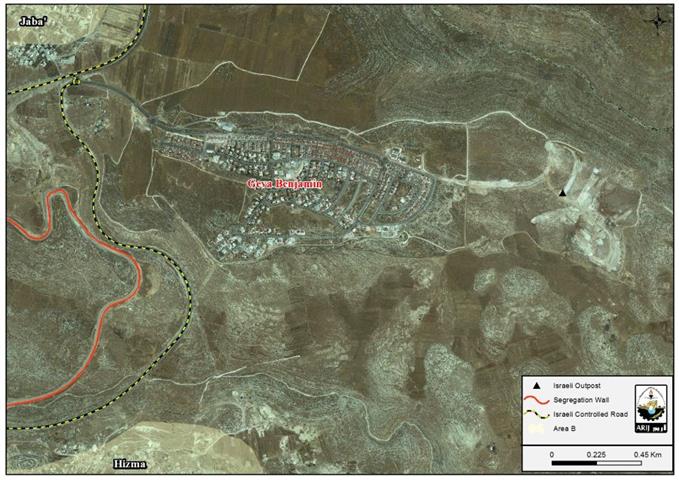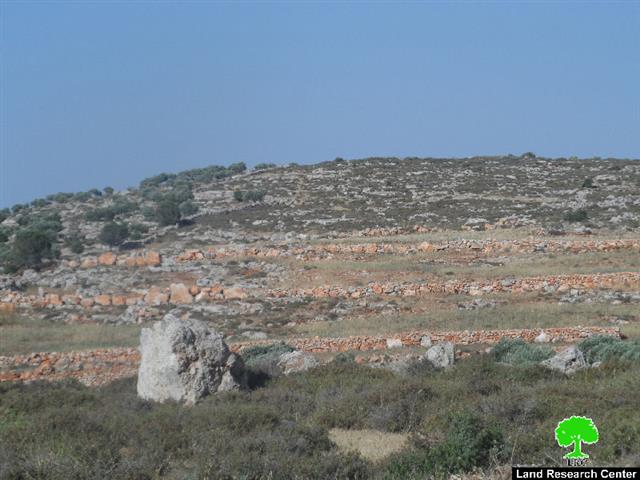The Israeli Government approved, on the 8th of May 2014, a tender to build tens of settlement units in Adam (Geva’ Benyamin) settlement northeast of Jerusalem city. The tender holds no. 9/2014 and states the construction of 75 new settlement units in the Adam settlement, allowing for the expansion of the settlement from its eastern side. Note that the tender was first published on the 10th of January 2014, along with other Israeli tenders to build around 1400 new settlement units in a number of Israeli settlements in the occupied West Bank, including those in east Jerusalem[1]
|
Table 1: Israeli tenders to build new housing units in Israeli settlements in the occupied West Bank |
|||
|
No. |
Governorate |
Settlement Name |
No. of Settlement units |
|
1 |
Qalqilyia |
Karnei Shomron |
86 |
|
2 |
Qalqilyia |
Immanuel |
102 |
|
3 |
Bethlehem |
Efrat |
227 |
|
4 |
Qalqilyia |
Alfei Menashe |
78 |
|
5 |
Salfit |
Ariel |
40 |
|
6 |
Jerusalem |
Geva Benyamin (Adam) |
75 |
|
7 |
Bethlehem |
Betar Illit |
24 |
|
8 |
Salfit |
Elkana |
169 |
|
9 |
Jerusalem |
Pisgat Zeev |
182 |
|
10 |
Jerusalem |
Ramot |
294 |
|
11 |
Jerusalem |
Neve Yacoov |
56 |
|
Total Units |
1333 |
||
The released tender targeting Adam (Geva’ Benyamin) settlement is just a cover to a broader plan that Israel plans to implement in the settlement and its surrounding which aims at linking Adam (Geva’ Benyamin) settlement (located in J2[2] area) with Israeli settlements located inside the municipal boundaries of Jerusalem (J1 area), most especially the settlements of Pisgat Ze’ev, Pisgat Amir and Neve Yacoov, which are the closest to the settlement from the western side and are semi-detached from it today due to the construction of the Israeli Segregation wall around Jerusalem city. See Map 1
Furthermore, the location of the new settlement units that are planned to be built in the eastern side of Adam (Geva’ Benyamin) settlement will be implemented on a land previously declared by Israel during the eighties as “State Land” [3]. Additionally, the area surrounding Adam (Geva’ Benyamin) settlement from its western side is also declared as “State Land” and Israel is planning to use this area in the future to implement further for colonial plans and to create a geographical contiguity between Adam settlement and Israeli settlements inside the municipal boundaries of Jerusalem.
Adam (Geva’ Benyamin) Settlement, Geography and population
The settlement was established in 1983 on lands previously confiscated from Jaba’ village northeast of Jerusalem city. Today, the settlement occupies a total land area of 1194 dunums and is home to 4627 Israeli settlers. The settlement is located outside Jerusalem city municipal boundary which was illegally and unilaterally redrawn in 1967 when Israel occupied the West Bank including East Jerusalem and the Gaza Strip.
To conclude,
Despite international denunciation, Israel continues to proceed with settlement construction in the occupied West Bank and most specifically in East Jerusalem in violation of the most important document of international humanitarian law- the Fourth Geneva Convention Relative to the Protection of Civilian Persons in a Time of War (hereinafter the Convention) and the Hague Regulations of 1907 which contains specific provisions outlawing Israel’s colonization activities.
- Article (49) of the Convention (IV) relative to the Protection of Civilian Persons in Time of War, Geneva, issued on 12 August 1949 – Part III states that ' The Occupying Power shall not deport or transfer parts of its own civilian population into the territory it occupies.'
- Article XXXI of the 1995 Oslo agreement provides that: Israel is forbidden from building or planning to any project or settlements or any colonial expansion or any plan that lead to change the status of the West Bank and Gaza Strip. The article provides “Neither side shall initiate or take any step that will change the status of the West Bank and the Gaza Strip pending the outcome of the permanent status negotiations”.
- Moreover United Nations Security Council, Resolution 446 March 22, 1979 calls on Israel to rescind its previous measures and to desist from taking any action which would result in changing the legal status and geographical nature and materially affecting the demographic composition of the Arab territories occupied since 1967, including Jerusalem and, in particular, not to transfer parts of its own civilian population into the occupied Arab territories'.
- Also the resolution 452 of the 1979 “calls upon the Government and people of Israel to cease, on an urgent basis, the establishment, construction and planning of settlements in the Arab territories occupied since 1967, including Jerusalem.
- Article 49 paragraph 6 in the Fourth Geneva Convention that” The occupying power shall not deport or transfer parts of its own population into the territories it occupies.”
[1] Settlement housing tenders published, Lapid vows units won't be built
http://www.ynetnews.com/articles/0,7340,L-4475310,00.html
[2] Settlements in Jerusalem Governorate are classified according to their administrative status: settlements inside the municipal boundary (the J1 area), they are: The Jewish Quarter, Neve Yacoov, Pisgat Ze’ev, Pisgat Amir, Nof Zion, East Telpiot, Atarot, Ramot Allon, Ramat Shlomo (Rechecs Shu’fat), Rama Eshkol, Hebrew University (Har Hazofim),Giv’at Shapira, Settlers Houses in Jerusalem, Mamilla ,Gilo, Har Homa, Ras Al Amoud (Ma’ale Hazeitim) and Giv’at Hamatos. Settlements within the Jerusalem governorate and outside the municipal boundary (the J2 area), they are: Ma’ale Adumim, Mishor Adumim, Kfar Adumim, Almon (Anatot), Kedar, Mitzpe Yedude, Neve Brat, Allon, Neve Samuel, Har Samuel, Har Adar, Giv’at Ze’ev, Kalya, Roman Bating House, Giv’on Hadasha, Giv’on, Har Adar. Kochav Yacov, Geva’ Benyamin (Adam), Sha’are Benyamin and Mevesert Zion.
[3] Foundations of civil and political rights in Israel and the occupied territories
http://aladinrc.wrlc.org/bitstream/handle/1961/5069/9783638944502.pdf?sequence=1
Prepared by:
The Applied Research Institute – Jerusalem















